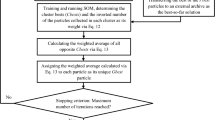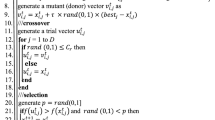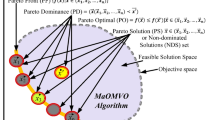Abstract
Solving many-objective optimization problems has become one of the most popular research areas in recent years due to its ever-increasing applications in industries and other fields. In this paper, a novel two-phase hybrid feeder (TPHF) is proposed to provide elite solutions for selection mechanism of many-objective optimization algorithms (MaOAs) to improve their performance. The proposed TPHF framework generates solutions using a novel particle swarm optimization (PSO) operator along with a genetic algorithm operator during a two-phase calculated search based on the average velocity of the PSO particles. TPHF focuses on the worst solutions of the population to find a better place for them. Therefore, it frequently resets the PSO particles to the worst solutions. The new PSO operator uses the novel idea of dynamic inertia and learning factors and a novel velocity update equation. The classic global bests set of the classic PSO operator is replaced by a PSO feeder which uses the novel idea of using groups of the best/worst solutions to feed the new PSO operator based on the phase of the search. The proposed TPHF is applied to some of the most famous and state-of-the-art MaOAs with their corresponding default parameters. The result of the comparison between these MaOAs with their corresponding TPHF versions on MaF test suite shows a significant improvement in the performance of the TPHF versions in 62.2% of the cases.
Graphical abstract











Similar content being viewed by others
Explore related subjects
Discover the latest articles, news and stories from top researchers in related subjects.References
Deb K, Pratap A, Agarwal S, Meyarivan T (2002) A fast and elitist multiobjective genetic algorithm: Nsga-ii. IEEE Trans Evolut Comput 6(2):182–197
Soto C et al (2020) Solving the multi-objective flexible job shop scheduling problem with a novel parallel branch and bound algorithm. Swarm Evolut Comput 53:100632
Li Q, Cao Z, Ding W, Li Q (2020) A multi-objective adaptive evolutionary algorithm to extract communities in networks. Swarm Evolut Comput 52:100629
Zhang Y, Gong D-W, Gao X-Z, Tian T, Sun X-Y (2020) Binary differential evolution with self-learning for multi-objective feature selection. Inf Sci 507:67–85
Abualigah LMQ et al (2019) Feature selection and enhanced krill herd algorithm for text document clustering. Springer, Berlin
Abualigah LM, Khader AT (2017) Unsupervised text feature selection technique based on hybrid particle swarm optimization algorithm with genetic operators for the text clustering. J Supercomput 73(11):4773–4795
Yang Y, Yang B, Wang S, Jin T, Li S (2020) An enhanced multi-objective grey wolf optimizer for service composition in cloud manufacturing. Appl Soft Comput 87:106003
Zitzler E (1999) Evolutionary algorithms for multiobjective optimization: Methods and applications, vol 63. Citeseer
Zitzler E, Laumanns M, Thiele L (2019) Spea2: Improving the strength pareto evolutionary algorithm. TIK-report 103
Srinivas N, Deb K (1994) Multiobjective optimization using nondominated sorting in genetic algorithms. Evolut Comput 2(3):221–248
Knowles J, Corne D (1999) The pareto archived evolution strategy: A new baseline algorithm for pareto multiobjective optimisation. IEEE, vol 1. pp 98–105
Zhang X, Zheng X, Cheng R, Qiu J, Jin Y (2018) A competitive mechanism based multi-objective particle swarm optimizer with fast convergence. Inf Sci 427:63–76
Lin Q, Li J, Du Z, Chen J, Ming Z (2015) A novel multi-objective particle swarm optimization with multiple search strategies. Eur J Op Res 247(3):732–744
Khare V, Yao X, Deb K (2003) Performance scaling of multi-objective evolutionary algorithms. Springer, pp 376–390
Purshouse RC, Fleming PJ (2003) Evolutionary many-objective optimisation: An exploratory analysis. IEEE, vol 3. pp 2066–2073
Purshouse RC, Fleming PJ (2007) On the evolutionary optimization of many conflicting objectives. IEEE Trans Evolut Comput 11(6):770–784
Chand S, Wagner M (2015) Evolutionary many-objective optimization: a quick-start guide. Surv Op Res Manag Sci 20(2):35–42
Panichella A (2019) An adaptive evolutionary algorithm based on non-euclidean geometry for many-objective optimization. 595–603
Sun Y, Yen GG, Yi Z (2018) Igd indicator-based evolutionary algorithm for many-objective optimization problems. IEEE Trans Evolut Comput 23(2):173–187
Coello C, Lamont G, Van Veldhuizen D (2007) Evolutionary algorithms for solving multi-objective problems, 2nd edn. Springer-Verlag, New York Inc
Van Veldhuizen DA (1999) Multiobjective evolutionary algorithms: classifications, analyses, and new innovations. Tech. Rep., Air force Inst of Tech Wright-Patterson AFB OH school of engineering and management
Coello CAC, Lamont GB (2004) Applications of multi-objective evolutionary algorithms, vol 1. World Scientific, Singapore
Coello CAC (2002) Theoretical and numerical constraint-handling techniques used with evolutionary algorithms: a survey of the state of the art. Comput Methods Appl Mech Eng 191(11–12):1245–1287
Yuan Y, Xu H, Wang B, Yao X (2015) A new dominance relation-based evolutionary algorithm for many-objective optimization. IEEE Trans Evolut Comput 20(1):16–37
Wang H, He S, Yao X (2017) Nadir point estimation for many-objective optimization problems based on emphasized critical regions. Soft Comput 21(9):2283–2295
Das I, Dennis JE (1998) Normal-boundary intersection: A new method for generating the pareto surface in nonlinear multicriteria optimization problems. SIAM J Optim 8(3):631–657
Zhang X, Tian Y, Jin Y (2014) A knee point-driven evolutionary algorithm for many-objective optimization. IEEE Trans Evolut Comput 19(6):761–776
Deb K, Miettinen K (2009) A review of nadir point estimation procedures using evolutionary approaches: A tale of dimensionality reduction. 1–14
Deb K, Miettinen K, Chaudhuri S (2010) Toward an estimation of nadir objective vector using a hybrid of evolutionary and local search approaches. IEEE Trans Evolut Comput 14(6):821–841
Michalewicz Z, Fogel DB (2013) How to solve it: modern heuristics. Springer Science & Business Media, Germany
Goldberg DE (1989) Genetic algorithms in search. Optimization, and MachineLearning. Addion wesley
Husbands P (1992) Genetic algorithms in optimisation and adaptation. Halsted Press, Canberra, pp 227–276
Vicini A, Quagliarella D, Vicini A, Quagliarella D (1997) Multipoint transonic airfoil design by means of a multiobjective genetic algorithm. In: 35th Aerospace Sciences Meeting and Exhibit, p 82. https://doi.org/10.2514/6.1997-82
Kirkpatrick S, Gelatt CD, Vecchi MP (1983) Optimization by simulated annealing. science 220(4598):671–680
Osycska A (1984) Multi-Criterion Optimization in Engineering with Fortran Examples. Halstad Press, New York, NY. https://www.worldcat.org/title/multicriterion-optimization-in-engineering-withfortran-programs/oclc/10275539
Glover F, Laguna M (1998) Tabu search. Springer, Boston, pp 2093–2229
Michalewicz Z, Hartley SJ (1996) Genetic algorithms+ data structures= evolution programs. Mathl Intell 18(3):71
Back T (1996) Evolutionary algorithms in theory and practice: Evolution strategies, evolutionary programming, genetic algorithms. Oxford University Press, United Kingdom
Eberhart R, Kennedy J (1995) Particle swarm optimization. Citeseer, vol 4. pp 1942–1948
Mirjalili S, Mirjalili SM, Hatamlou A (2016) Multi-verse optimizer: a nature-inspired algorithm for global optimization. Neural Comput Appl 27(2):495–513
Abualigah L (2020) Multi-verse optimizer algorithm: a comprehensive survey of its results, variants, and applications. Neural Comput Appl 32(16):12381–12401
Lamont GB (1993) Compendium of Parallel Programs for the Intel iPSC Computers. Wright-Patterson AFB, OH 45433
Fogel DB, Computation E (1995) Toward a new philosophy of machine intelligence. IEEE Evolut Comput
Deb K (2001) Multi-objective optimization using evolutionary algorithms, vol 16. John Wiley, New Jersey
Garza-Fabre M, Pulido GT, Coello CAC (2009) Ranking methods for many-objective optimization. Springer, pp 633–645
Deb K, Jain H (2013) An evolutionary many-objective optimization algorithm using reference-point-based nondominated sorting approach, part i: solving problems with box constraints. IEEE Trans Evolut Comput 18(4):577–601
Zhu Q et al (2019) An elite gene guided reproduction operator for many-objective optimization. IEEE Trans Cybern 51(2):765–778
Jiang S, He X, Zhou Y (2019) Many-objective evolutionary algorithm based on adaptive weighted decomposition. Appl Soft Comput 84:105731
Chen G, Li J (2019) A diversity ranking based evolutionary algorithm for multi-objective and many-objective optimization. Swarm Evolut Comput 48:274–287
Zhang Q, Li H (2007) Moea/d: a multiobjective evolutionary algorithm based on decomposition. IEEE Trans Evolut Comput 11(6):712–731
Liang Z, Zeng J, Liu L, Zhu Z (2021) A many-objective optimization algorithm with mutation strategy based on variable classification and elite individual. Swarm Evolut Comput 60:100769
Zou X, Chen Y, Liu M, Kang L (2008) A new evolutionary algorithm for solving many-objective optimization problems. IEEE Trans Syst Man Cybern Part B (Cybernetics) 38(5):1402–1412
Bader J, Zitzler E (2011) Hype: an algorithm for fast hypervolume-based many-objective optimization. Evolut Comput 19(1):45–76
Liang Z, Hu K, Ma X, Zhu Z (2019) A many-objective evolutionary algorithm based on a two-round selection strategy. IEEE Trans Cybern 51(3):1417–1429
Cheng R, Jin Y, Olhofer M, Sendhoff B (2016) A reference vector guided evolutionary algorithm for many-objective optimization. IEEE Trans Evolut Comput 20(5):773–791
Coello CC, Lechuga MS (2002) Mopso: A proposal for multiple objective particle swarm optimization. IEEE, vol 2. pp 1051–1056
Dai C, Wang Y, Ye M (2015) A new multi-objective particle swarm optimization algorithm based on decomposition. Inf Sci 325:541–557
Zapotecas Martínez S, Coello Coello CA (2011) A multi-objective particle swarm optimizer based on decomposition. pp. 69–76
Nebro AJ et al (2009) Smpso: A new pso-based metaheuristic for multi-objective optimization. IEEE, pp 66–73
Peng W, Zhang Q (2008) A decomposition-based multi-objective particle swarm optimization algorithm for continuous optimization problems. IEEE, pp 534–537
Sierra MR, Coello Coello CA (2005) Improving pso-based multi-objective optimization using crowding, mutation and \(\epsilon\)-dominance. Springer, pp 505–519
Zhan Z-H et al (2013) Multiple populations for multiple objectives: a co-evolutionary technique for solving multi-objective optimization problems. IEEE Trans Cybern 43(2):445–463
Knowles JD, Corne DW (2000) Approximating the nondominated front using the pareto archived evolution strategy. Evolut Comput 8(2):149–172
Hu W, Yen GG (2013) Adaptive multiobjective particle swarm optimization based on parallel cell coordinate system. IEEE Trans Evolut Comput 19(1):1–18
Zitzler E, Thiele L (1998) Multiobjective optimization using evolutionary algorithms–a comparative case study. Springer, pp 292–301
Ding R, Dong H, He J, Li T (2019) A novel two-archive strategy for evolutionary many-objective optimization algorithm based on reference points. Appl Soft Comput 78:447–464
Luo J, Huang X, Li X, Gao K (2019) A novel particle swarm optimizer for many-objective optimization. IEEE, pp 958–965
Lin Q et al (2016) Particle swarm optimization with a balanceable fitness estimation for many-objective optimization problems. IEEE Trans Evolut Comput 22(1):32–46
Tian Y, Cheng R, Zhang X, Jin Y (2017) Platemo: A matlab platform for evolutionary multi-objective optimization [educational forum]. IEEE Comput Intell Mag 12(4):73–87
Sindhya K, Miettinen K, Deb K (2012) A hybrid framework for evolutionary multi-objective optimization. IEEE Trans Evolut Comput 17(4):495–511
Lin Q et al (2015) A hybrid evolutionary immune algorithm for multiobjective optimization problems. IEEE Trans Evolut Comput 20(5):711–729
Tian Y, Zheng X, Zhang X, Jin Y (2019) Efficient large-scale multiobjective optimization based on a competitive swarm optimizer. IEEE Trans Cybern 50(8):3696–3708
Cheng R et al (2017) A benchmark test suite for evolutionary many-objective optimization. Complex Intell Syst 3(1):67–81
Huband S, Hingston P, Barone L, While L (2006) A review of multiobjective test problems and a scalable test problem toolkit. IEEE Trans Evolut Comput 10(5):477–506
Deb K, Thiele L, Laumanns M, Zitzler E (2005) Scalable test problems for evolutionary multiobjective optimization. Springer, London, pp 105–145
Jain H, Deb K (2013) An evolutionary many-objective optimization algorithm using reference-point based nondominated sorting approach, part ii: handling constraints and extending to an adaptive approach. IEEE Trans Evolut Comput 18(4):602–622
Brockhoff D, Zitzler E (2009) Objective reduction in evolutionary multiobjective optimization: theory and applications. Evolut Comput 17(2):135–166
Deb K, Saxena D, et al (2006) Searching for pareto-optimal solutions through dimensionality reduction for certain large-dimensional multi-objective optimization problems. pp. 3352–3360
Köppen M, Yoshida K (2007) Substitute distance assignments in nsga-ii for handling many-objective optimization problems. Springer, pp 727–741
Ishibuchi H, Hitotsuyanagi Y, Tsukamoto N, Nojima Y (2010) Many-objective test problems to visually examine the behavior of multiobjective evolution in a decision space. Springer, pp 91–100
Li M, Grosan C, Yang S, Liu X, Yao X (2017) Multiline distance minimization: a visualized many-objective test problem suite. IEEE Trans Evolut Comput 22(1):61–78
Saxena DK, Zhang Q, Duro JA, Tiwari A (2011) Framework for many-objective test problems with both simple and complicated pareto-set shapes. Springer, pp 197–211
Cheng R, Jin Y, Olhofer M et al (2016) Test problems for large-scale multiobjective and many-objective optimization. IEEE Trans Cybern 47(12):4108–4121
Zitzler E, Thiele L, Laumanns M, Fonseca CM, Da Fonseca VG (2003) Performance assessment of multiobjective optimizers: an analysis and review. IEEE Trans Evolut Comput 7(2):117–132
Mann HB, Whitney DR (1947 ) On a test of whether one of two random variables is stochastically larger than the other. Annals Mathematical Stat. 18(1):50–60. https://doi.org/10.1214/aoms/1177730491 ,https://projecteuclid.org/journals/annals-of-mathematical-statistics/volume-18/issue-1/On-a-Test-of-Whether-one-of-Two-Random-Variables/10.1214/aoms/1177730491.full
Steel RGD, Torrie JH (1986) Principles and procedures of statistics: a biometrical approach. McGraw-Hill, New York
Chaffi BN, Tafreshi FS (2019) Nasseh method to visualize high-dimensional data. Appl Soft Comput 84:105722
Acknowledgements
We wish to acknowledge the efforts of Mrs. Narges Sayyadi for proofreading this paper.
Author information
Authors and Affiliations
Corresponding author
Ethics declarations
Conflict of interest
The authors declare that they have no known competing financial interests or personal relationships that could have appeared to influence the work reported in this paper.
Additional information
Publisher's Note
Springer Nature remains neutral with regard to jurisdictional claims in published maps and institutional affiliations.
Rights and permissions
Springer Nature or its licensor holds exclusive rights to this article under a publishing agreement with the author(s) or other rightsholder(s); author self-archiving of the accepted manuscript version of this article is solely governed by the terms of such publishing agreement and applicable law.
About this article
Cite this article
Nasseh Chaffi, B., Rahmani, M. A novel two-phase hybrid selection mechanism feeder to improve performance of many-objective optimization algorithms. Evol. Intel. 17, 889–920 (2024). https://doi.org/10.1007/s12065-022-00763-6
Received:
Revised:
Accepted:
Published:
Issue Date:
DOI: https://doi.org/10.1007/s12065-022-00763-6




